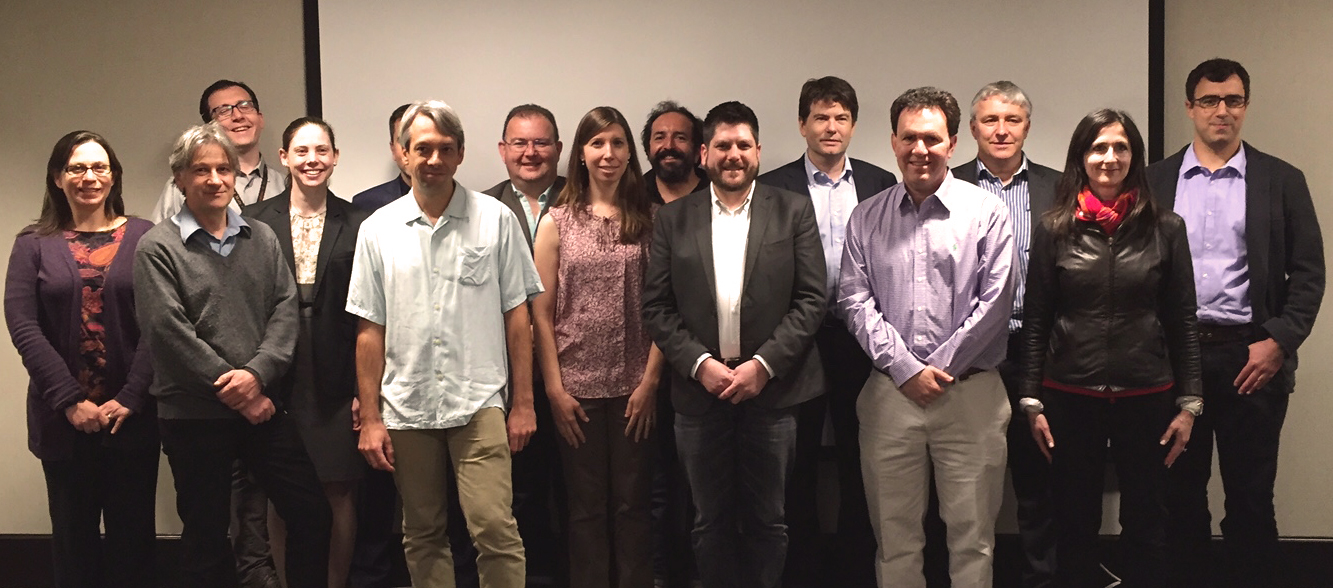MEET THE TEAM

Scott Gaudi, Ohio State University
Astronomer who bridges the gap between theory and observations, with extensive experience in leadership roles and consensus-building, as well as experience with several exoplanet detection methods and exoplanet surveys.
Sara Seager, Massachusetts Institute of Technology
Planetary scientist with expertise in exoplanet atmospheres and biosignature gases.
Study Scientist and co-chair of the STDT
Bertrand Mennesson, NASA Jet Propulsion Laboratory
Observational astrophysicist with expertise in the design, assembly, commissioning and scientific exploitation of high contrast/high resolution instruments used in exoplanetary systems studies.
Ex-Officio non-voting members of the STDT
Martin Still, NASA Headquarters
Program Scientist providing a bridge between the STDT members and the plans and policies of the NASA administration and ensuring that the study remains on course in terms of science plan and delivery of its milestone products.
Douglas Hudgins, NASA Headquarters
Deputy Program Scientist
Keith Warfield, NASA Jet Propulsion Laboratory
Study Manager overseeing the engineering, documentation and logistical support to the HabEx STDT over the course of the study.
International ex-officio non-voting members of the STDT
Christian Marois, NRC Canada (Canadian Space Agency, CSA, Observer)
Observational astrophysicist with a knowledge of ground-based adaptive optics campaigns and instruments for current and future telescopes, and expertise in simulating instrument performances, designing observing strategies, and at data processing for imaging exoplanets.
David Mouillet, IPAG Grenoble (Centre National d’Etudes Spatiales, CNES, Observer)
Former project scientist of the ESO-SPHERE instrument with expertise in science and technical definition studies, actual development and tests of a ground-based high contrast imager, and insight into the European ground- and space-based program and technology development perspective.
Timo Prusti, ESA (European Space Agency, ESA, Observer)
Gaia Project Scientist acting as the Interface to ESA and link to ESA science missions of relevance to HabEx.
Andreas Quirrenbach, Heidelberg University (Deutschen Zentrums für Luft- und Raumfahrt, DLR, Observer)
Astronomer acting as the interface to DLR and link to HabEx.
Motohide Tamura, University of Tokyo (Japanese Aerospace Exploration Agency, JAXA, Observer)
Observational and infrared astronomer with expertise in high contrast imaging, infrared radial velocity, and polarimetric studies of exoplanets/disks.
Members of the STDT
Kerri Cahoy, Massachusetts Institute of Technology
Developer of atmospheric remote sensing instruments, with expertise in satellite engineering, exoplanet atmosphere radiative transfer modeling, and wavefront sensing and control, and valuable insight from being a member of the Exo-C STDT, chairing the Exo-C Extended Study Team, and being a member of the WFIRST coronagraph instrument science investigation team.
John T. Clarke, Boston University
A planetary scientist who specializes in far-UV observations of solar system bodies, who also has extensive experience with the instrument and mission development of the Hubble Space Telescope, MAVEN, and several sounding rockets.
Shawn Domagal-Goldman, NASA Goddard Space Flight Center
Astrobiologist with experience in various biosignatures and their false positives, from iron isotopes in the rock record of Mars and Earth to remotely detectable gases on exoplanets.
Lee Feinberg, NASA Goddard Space Flight Center
Optical engineer with expertise in UV-optical space instruments, large space telescopes and related systems, technology development, and ultra-stable systems.
Olivier Guyon, University of Arizona
Astronomer and Optical Physicist with expertise in exoplanet imaging techniques (coronagraphy, adaptive optics), and designs coronagraph systems for ground and space-based exoplanet imaging missions.
Jeremy Kasdin, Princeton University
Professor of Mechanical and Aerospace Engineering who is the Adjutant scientist for the WFIRST Coronagraph Instrument and has spent the last 16 years researching coronagraph technology and wavefront control approaches as well as leading research into starshade technology.
Dimitri Mawet, California Institute of Technology
Associate professor in Astronomy with expertise in direct imaging and high resolution spectroscopic characterization of whole extra solar planetary systems and developing innovative integrated wavefront control, coronagraphic and spectroscopic approaches that seek maximum synergies between large ground and space based telescopes such as HabEx.
Tyler Robinson, University of California Santa Cruz
Planetary scientist and astronomer with expertise in exoplanetary atmospheric processes, and in building tools to predict and interpret the spectra of a variety of worlds.
Leslie Rogers, University of Chicago
Theoretical physicist with expertise in planet population statistics as well as the formation, interior structure, and evolution of low-mass planets.
Paul Scowen, Arizona State University
Observational astronomer and instrumentalist with experience studying star and planet formation from space with HST and with the design and development of detectors, coatings and optical systems for next generation suborbital and space-based observatories.
Rachel Somerville, Rutgers University
Theoretical astrophysicist with research interests in the formation and evolution of galaxies and supermassive black holes in a cosmological context, and deep multiwavelength surveys.
Karl Stapelfeldt, NASA Jet Propulsion Laboratory
Chief Scientist of the NASA Exoplanet Exploration Program with expertise in multi-wavelength observations and modeling of circumstellar disks; high contrast imaging; space astronomy missions (HST, Spitzer, Herschel); and exoplanet mission studies (Exo-C, ACCESS, ATLAST, TPF-C ... )
Chris Stark, Space Telescope Science Institute
A leading expert on science yield calculations for future direct imaging missions, who also has extensive experience in modeling and observing debris disks and understanding of the impact of exozodiacal dust on the search for Earth-like planets.
Daniel Stern, NASA Jet Propulsion Laboratory
Extragalactic observer, studying a range of source classes outside our Galaxy, from black holes to galaxy clusters.
Margaret Turnbull, SETI Institute
Astrobiologist with expertise in target systems, exoplanet detectability and optimal observing strategies, based on her experience as an Exo-S probe study team member and as the science lead for the New Worlds Observer, a starshade concept similar in scale to HabEx.
Who To Contact
Scott Gaudi: gaudi.1@osu.edu
Sara Seager: seager@mit.edu
Bertrand Mennesson: Bertrand.Mennesson@jpl.nasa.gov

